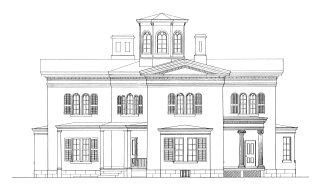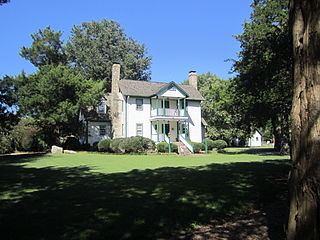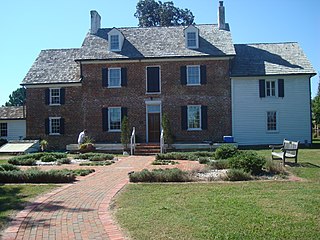
Shirley Plantation is an estate on the north bank of the James River in Charles City County, Virginia. It is located on scenic byway State Route 5, between Richmond and Williamsburg. It is the oldest active plantation in Virginia, settled in 1613 and is also the oldest family-owned business in North America, when it was acquired by the Hill family, with operations starting in 1638. White indentured servants were initially used as the main labor force until the early 1700s, when black slavery became the primary source of Virginian labor. It used about 70 to 90 African slaves at a time for plowing the fields, cleaning, childcare, and cooking. It was added to the National Register in 1969 and declared a National Historic Landmark in 1970. After the acquisition, rebranding, and merger of Tuttle Farm in Dover, New Hampshire, Shirley Plantation received the title of the oldest business continuously operating in the United States.

Cooleemee, also known as the Cooleemee Plantation House, is a house located between Mocksville and Lexington, North Carolina, at the terminus of SR 1812 on the Yadkin River in Davie County, North Carolina. It is a U.S. National Historic Landmark, designated in 1978 for its architecture.

Chippokes State Park is a Virginia state park on the south side of the James River on the Captain John Smith Chesapeake National Historic Trail. In addition to forests and fossil hunting on the beach, it includes three historic houses as well as an open-air agricultural and forestry museum with seasonally appropriate events. Other recreational facilities include a visitor center, swimming pool, hiking trails, cabins, yurts and campgrounds). As of 2020, the yearly visitation was 173,110. It is located at 695 Chippokes Park Road, in rural Surry County, Virginia off Route 10.

Stagville Plantation is located in Durham County, North Carolina. With buildings constructed from the late 18th century to the mid-19th century, Stagville was part of one of the largest plantation complexes in the American South. The entire complex was owned by the Bennehan, Mantack and Cameron families; it comprised roughly 30,000 acres (120 km2) and was home to almost 900 enslaved African Americans in 1860.

Boone Hall Plantation is a historic district located in Mount Pleasant, Charleston County, South Carolina, United States and listed on the National Register of Historic Places. The plantation is one of America's oldest plantations still in operation, as it has continually produced agricultural crops for over 320 years. The majority of this labor, as well as the construction of the buildings and its characteristic bricks, was performed by enslaved African Americans, aside from the main building, which was built in 1936. For this reason, the site was named one of the African American Historic Places in South Carolina in 2009. The historic district includes a 1936 Colonial Revival-style dwelling, and multiple significant landscape features, including an allée of southern live oak trees, believed to have been planted in 1743. The site is open for public tours.

Gaineswood is a plantation house in Demopolis, Alabama, United States. It is the grandest plantation house ever built in Marengo County and is one of the most significant remaining examples of Greek Revival architecture in Alabama.

Faunsdale Plantation is a historic slave plantation near the town of Faunsdale, Alabama, United States. This plantation is in the Black Belt, a section of the state developed for cotton plantations. Until the U.S. Civil War, planters held as many as 186 enslaved African Americans as laborers to raise cotton as a commodity crop.

Tuckahoe, also known as Tuckahoe Plantation, or Historic Tuckahoe is located in Tuckahoe, Virginia on Route 650 near Manakin Sabot, Virginia, overlapping both Goochland and Henrico counties, six miles from the town of the same name. Built in the first half of the 18th century, it is a well-preserved example of a colonial plantation house and is particularly distinctive as a colonial prodigy house. Thomas Jefferson is also recorded as having spent some of his childhood here. It was declared a National Historic Landmark in 1969.

The Bennett Bunn Plantation is a historic farm near Zebulon, North Carolina, a suburb of Raleigh. The plantation, located beside US 264 in eastern Wake County, consists of a two-story house, built in 1833, barns, and 162 acres (66 ha) of farmland and forests. The property was owned by generations of the Bunn family until 2000 when Grace Hutchins, great-granddaughter of Bennet Bunn, sold the property for $1.9 million. The home is still used as a private residence and was listed on the National Register of Historic Places in February 1986.

Rose Hill Plantation State Historic Site is a historic site in Union County, South Carolina, that preserves the home of William H. Gist (1807–1874), the 68th governor of South Carolina. Gist helped instigate a Secession Convention in South Carolina, which led to the creation of the Ordinance of Secession that preceded the Civil War.

Rose Hill Plantation House is an historic Carpenter Gothic house located on US 278 in Bluffton, Beaufort County, South Carolina. It was begun in 1858 for Dr. John Kirk and Caroline Kerk, his wife, but construction was interrupted by the Civil War and not resumed until after World War II when it was renovated and finished by architect Willis Irvin for John Sturgeon and Florence Sturgeon, his wife. On May 19, 1983, it was added to the National Register of Historic Places. It preserves the antebellum plantation home of Dr. & Mrs. John William (1803-1868) & Caroline (1815-1864) Kirk, a wealthy planter and physician.

Travellers Rest, also known as Golgotha, is a former plantation and historic plantation house, located in Nashville, Tennessee. The first owner of the site was John Overton in 1796, who built the first family home in 1799. For many years this plantation was worked and maintained by enslaved Black people.

Rose Hill Manor, now known as Rose Hill Manor Park & Children's Museum, is a historic home located at Frederick, Frederick County, Maryland. It is a 2+1⁄2-story brick house. A notable feature is the large two-story pedimented portico supported by fluted Doric columns on the first floor and Ionic columns on the balustraded second floor. It was the retirement home of Thomas Johnson (1732–1819), the first elected governor of the State of Maryland and Associate Justice of the United States Supreme Court. It was built in the mid-1790s by his daughter and son-in-law.

Ferry Plantation House, or Old Donation Farm, Ferry Farm, Walke Manor House, is a brick house in the neighborhood of Old Donation Farm in Virginia Beach, Virginia. The site dates back to 1642 when Savill Gaskin started the second ferry service in Hampton Roads to carry passengers on the Lynnhaven River to the nearby county courthouse and to visit plantations along the waterway. A cannon was used to signal the ferry, which had 11 total stops along the river. The first ferry service was started nearby by Adam Thoroughgood.

Cedar Grove Plantation is a historic house located in Huntersville, North Carolina and built between 1831 and 1833. It was the home of James G. Torrance, a planter living in central Mecklenburg County. It is currently privately owned, and is closed to the public. The plantation was named for its location in the midst of a grove of Cedar trees.
Purefoy–Dunn Plantation is a historic plantation and national historic district located near Wake Forest, Wake County, North Carolina. The Greek Revival style plantation house was built about 1814 and remodeled about 1850. It is a two-story, L-shaped, heavy timber frame building. It has a low hipped roof and is sheathed in clapboards. The front portico was removed in the 1960s or early 1970s. Also on the property is a contributing mid-19th century gable-roofed frame smokehouse.




















